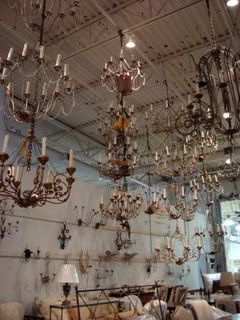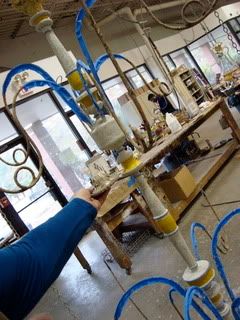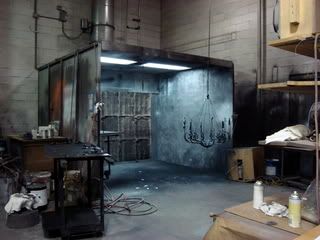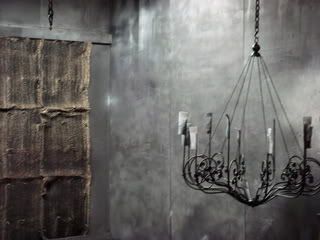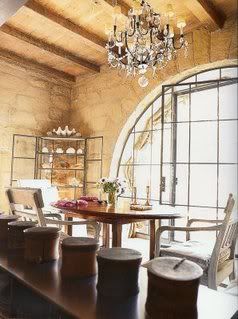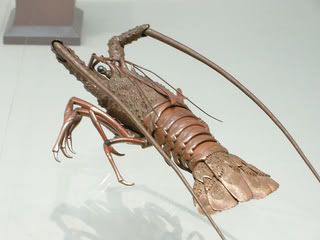My Externship with Eleanor McKay of Niermann-Weeks, part 1

Niermann Weeks is a company run by Eleanor McKay (my host for the externship) and her husband Joe Niermann. They create high-end lighting fixtures and furniture, all of which is heavily influenced by historical pieces and methods.
October 21st
On this first day of my externship I visited the Niermann Weeks showroom in DC to attend a meeting of a University of Maryland Alumni association, of which Eleanor is a member. There I met some UMd grads, professors, and even an alumna of the Language House (Chinese Cluster)! Of course I also got to meet Eleanor while viewing Niermann-Weeks’ pieces in person at the showroom.
Eleanor explained some details of the company to me. Although their clients include the interior designers of the wealthiest members of society and their creations have often graced the White House, they are still feeling the negative effects of the current bad economy. In fact, Niermann-Weeks has seen a 75% drop in business in the past three years. As Eleanor put it, “rich people need to start spending again.”
We went on to discuss the importance of the company breaking into online networking to remain successful and get ahead during this slump in the economy. They’re now utilizing tools like Facebook , Twitter, and a blog to gain attention and create interest. Niermann Weeks’ lighting was even recently awarded the Reader’s Choice Luxist Award—the winner of this award was chosen via online vote, proving that Eleanor is successfully utilizing new online communication methods to her company’s benefit.
November 2nd
This was a very exciting day as I got to see Niermann Weeks’ headquarters in Millersville, which houses both their offices and their factory. Well, not quite “factory,” since each of their pieces is handmade. It’s really more of a large workshop. “The University of Maryland taught me how to read, write, and think,” Eleanor told me as she gave me a preliminary tour of the workshop. Continuing her education post-grad is what enabled Eleanor to learn to catalogue and organize the vast amounts of information she had begin to acqure, allowing her to apply her history research to design problems.
Walking me through the building, Eleanor told me about the difficulty of working around changing fashions in an industry like hers. A great example of this is the fact that TV cases—those huge, imposing pieces that once graced everyone’s living room—are now obsolete thanks to flat screen TVs.
Entering the Niermann Weeks workshop.
Eleanor shows me an in-progress chandelier.
While introducing me to various artisans throughout the building (some were beading chandeliers, some were upholstering furniture, while others were preparing pieces for shipment), Eleanor explained that the work done by Niermann-Weeks requires differentiation between artists, craftspeople, and businesspeople. While those who fashion Niermann-Weeks’ pieces should certainly possess a certain artistry, they are really craftspeople whose job it is to reproduce a certain person’s (in this case Joe Niermann’s, the furniture designer’s) style. In addition, there need to be able businesspeople overseeing the company and ensuring that all is running smoothly.
Most of Niermann Weeks’ pieces receive their unique finished appearance by being sprayed with layers of texture-creating substances and paints. Because of their workshop’s proximity to waterways, they are extremely aware of the effects that their finishing processes could have on the surrounding ecosystem, and therefore use primarily water-based colors and sprays.
The station where all pieces receive their signature spray finishes.
All of Niermann-Weeks’ product reference older pieces, an their best sellers are items that look familiar because of their historical references, but are useful in modern life. Eleanor likes the “raw material” of history, she tells me while showing me some especially aged-looking pieces, which certainly shows Eleanor’s UMd History degree at work.
Eleanor discussed with me a specific difficulty the company is facing right right now—copyright laws and the fact that they now no longer cover furniture. This means that Niermann-Weeks cannot protect their designs, making knock-offs possible. Adding to this is the fact that Niermann Weeks has begin posting the prices of their pieces on their website, something that is unusual for such a company.
Although this unique transparency can help those who specialize in knocking off designers, it also makes the company and what it has to offer more accessible to potential customers, another tactic that can help Niermann Weeks overcome current financial troubles. As Eleanor put it, the furniture industry requires an infusion of new blood into its client base, so the more new attention their line receives, the better.
Again we touched on the current recession and how it’s affecting the company. When Eleanor and her husband started the company decades ago, it was during a different recession, but this one is not like other recessions, Eleanor explained to me, in that the rich still haven’t resumed their normal spending habits.
In light of our discussions about garnering attention via the internet, Eleanor asked me to begin creating a Wikipedia page for John Saladino, an interior designer who has been very influential, but who is not yet represented on this important information database.
A Saladino interior.
Talking to N.W.’s graphic designer and head of online information distribution
Since my areas of study are design and marketing, I was very excited to get to meet with Bill Gardner during my first visit to the Niermann Week’s headquarters. I had already touched on the subject of the online marketing of the company and its products with Eleanor.
Bill told me that his job is basically to “get the ideas out of Joe [Niermann]’s head” and to a place where they are accessible—in this case various places online. Bill is now utilizing social media including Facebook, a blog, and even Twitter. Since the sort of products Niermann Weeks produces are the first to be slashed in a bad economy, the company needed affordable and efficient advertising like that offered by the internet. Supplying the public (and potential customers) with details about their products and engaging information about the company and the people who run it has succeeded in giving N.W. a human face, which similar companies tend to lack. Leaders like Eleanor are able to see the benefit in trying new outlets like these before others and use them to succeed in even a very trying economic environment.
November 9
During out previous meeting, Eleanor had given me the task of researching articulated sculptures, which which Joe Niermann had taken to collecting, and find out about their history and discern their worth in today’s market. As it turned out, these creations, which almost always represent animals and insects with fully articulated limbs, originated in Japan and are called jizai okimono. As only a small handful of artisans still produce them today, they are increasingly valuable.
A spiny lobster jizai made by Takase Kozan, 20th Century.
Eleanor discussed the company’s upcoming sample sale with me, which really has the potential to make the company money for the year.
November 18
Niermann Weeks did fairly well at the sample sale. A particularly rewarding thing about the sale was that some people there recognized Eleanor from her blog on the Niermann-Weeks site and even quoted from it, affirming that the company’s online endeavors are indeed gaining them recognition and attention.
Eleanor and I poured over a few architectural magazines to see, by examining the ads and articles, which sorts of companies are managing to stay afloat. Eleanor also always makes a point of noting what’s new and who’s hot in the field of interior design and finds photo spreads that have used Niermann Weeks’ pieces in their compositions.
We also perused interior designers’ websites from the design and business perspective. Eleanor taught me a little about the history and atmosphere of the interior design world and how it’s been changing recently. In fact, part of the reason Eleanor and the company decided to take their merchandise online and make it more available the the wholesale marketplace is that their extremely wealthy clientele can be so needy and difficult to work with. Furthermore, over the past twenty years, the once-closed market of interior design has had to become more transparent because of the internet and the movement toward mass-produced luxury goods, so Niermann-Weeks’ changing tactics are indicative of a more wide-spread change throughout the interior design world.
In this economy, a huge part of Eleanor’s job as a leader is to keep a smile on her face and spread good cheer. She has a huge responsibility to all of Niermann Weeks’ employees to maintain a positive attitude, which can be instrumental in pulling any group of people out of a slump. Eleanor admits that she sometimes uses her arts and humanities education by reading voraciously as a form of escapism, which seems like a most beneficial thing—if she stays upbeat, she can pass that feeling on to her employees and coworkers. Since it remains difficult to plan for the future in an economy like today’s, this may be one of the most important jobs a leader has.

